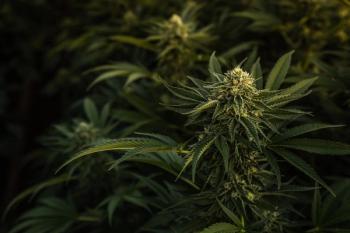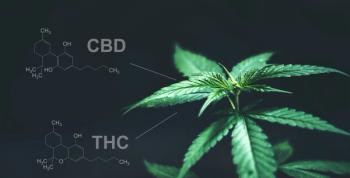
Cannabis Science and Technology
- November/December 2022
- Volume 5
- Issue 9
- Pages: 8-11
Principles of Chromatography, Part I: Theory

In part I in a new series of columns, we begin a discussion of the theory of chromatographic separations. Our goal is to derive equations that will help you better perform experiments to optimize your separations.
The two most commonly used potency measurement methods in cannabis analysis are infrared spectroscopy and chromatography. We have spent many months in this column on how to properly use infrared spectroscopy to determine analyte concentrations in cannabis samples. So, now we will discuss chromatography. In this first of a series of columns, I will begin a discussion of the theory of chromatographic separations. Our goal will be to derive equations that will help you better perform experiments to optimize your separations.
The word chromatography is Greek for color writing (1). It was discovered by Russian chemist Michael Tswett around 1900. The name refers to the fact that he used the technique to separate plant pigments, and in the glass columns he was using he could clearly see colored bands separating from each other. The importance of chromatography is underscored by the fact that two of its early practitioners, who laid much of the groundwork in the field, Archer J.P Martin and Richard L.M. Synge, were awarded the Nobel Prize in Chemistry in 1952 for their work (2). In an absurd byproduct of my research into the history of chromatography, I found there exists a record album called Chromatography by a band called Second Person, one of whose members is Julia Johnson, sister of former United Kingdom (UK) Prime Minister Boris Johnson (3). Small world, isn’t it?
Chromatography purifies mixtures by separating them into their components. An instrument that uses chromatography to separate a mixture is called a chromatograph. Many different types of chromatography are used depending upon the chemical species that need to be separated. A chromatograph makes use of chemical differences between analytes such that they spend different amounts of time inside the instrument. As a result, the different components come out of the instrument at different points in time. The separated chemical species can be identified or quantified using a detector. The detector used can vary from visual identification using the color of sample molecules when working with glass columns, to mass spectrometers (4). The output of a chromatograph is called a chromatogram, which is typically a plot of detector response on the y-axis versus time on the x-axis. Figure 1 shows an example of a chromatogram.
Note that this chromatogram is a plot of detector response versus time in minutes, and that there are seven peaks present. The position of each peak in a chromatogram is denoted by its retention time, a measure of how long an analyte spent inside the chromatograph. Note that the first peak in Figure 1 has a retention time of 9 min, and that the other peaks came out at later retention times. The size of the peak in a chromatogram can be used to measure the concentration of the chemical species in the original sample that gave rise to that peak (5).
The presence of seven peaks in Figure 1 means the detector saw at least seven different components from the sample exit the instrument. Assuming all components in the sample were completely separated, this means there were seven different components present in the sample. However, chromatography does not always completely separate all the components in a mixture. It is possible for different chemical species to have the same retention time. For example, there may be two or more chemical species responsible for the peak with a retention time of 9 min in Figure 1. Although laboratories sometimes use retention times to identify chemical species this should never be done since a retention time is not unique to a chemical species. Therefore, molecular identification techniques such as infrared spectroscopy (6,7) and mass spectrometry (5) should be used.
Chromatography Theory
Imagine a cylindrical tube, or column as it’s called in chromatography, of length (L), diameter (D), and radius (r) as shown in Figure 2.
The volume of this column is given by the equation for the volume of a cylinder which is seen in Equation 1:
where V is the column volume, r is the radius of column, and L is the length of column.
Now imagine that we pack our column with perfectly spherical particles all the same size (an oversimplification but needed here to keep things simple). This column packing is called a stationary phase because it does not move and is seen in Figure 2. An example of stationary phase is silica. Once the column is packed, the stationary phase will occupy a volume denoted by Vs, and the total empty space in the column, made up of the spaces and interstices between stationary phase particles, is called the void volume and is denoted by V0. Because the total contents of the column are simply the sum of the volumes of the stationary phase and the void volume, we can write an equation for the total column volume (Vt) as seen in Equation 2:
where Vt is the total column volume, Vs is the stationary phase volume, and V0 is the void volume.
In chromatography the mobile phase is a fluid that passes through the column. When our chromatographic column is filled with this fluid it will fill all the voids, thus the volume of the mobile phase or Vm is the same as the void volume V0, as shown in Equation 3:
where VM is the mobile phase volume and V0 is the void volume.
In gas chromatography (GC) the mobile phase is a gas such as hydrogen, nitrogen, or helium (5). GC has been used to measure cannabinoid concentrations (8) and terpene concentrations (9) in cannabis samples. In liquid phase chromatography the mobile phase is a liquid (5). An example of a liquid mobile phase that has been used to measure cannabinoids is a mixture of water and acetonitrile (9,10). We define the flow rate in a chromatographic experiment as the volume per unit time of mobile phase that exits the column. For example, if 1 mL of mobile phase exits the column per minute then the flow rate is 1 mL/min.
Imagine injecting a sample into the head of the column that has zero affinity for the stationary phase, that is, it will not absorb on or “stick to” the particles the column is packed with. As we will see, it is the fact that different molecules have different affinities for a given column packing that is behind the separation mechanism of chromatography (5,8–10). Since our molecule has zero affinity for the column packing, it will only have access to the voids and interstices in the column, that is, the void volume. Let’s assume our void volume is 1 mL. If the flow rate is 1 mL/min, all the mobile phase currently in the column will be flushed out of the column in 1 min. Along with it will come any molecules with zero affinity for the column. In this case, the chromatogram would have a peak 1 min after injection corresponding to the exiting of our zero affinity molecule from the column. In chromatography, the amount of time it takes a molecule with zero affinity for the stationary phase to exit the column is called the void time.
The Chromatographic Experimental Setup
Imagine we mix up some tetrahydrocannabinol (THC) in ethanol and inject it at the head of our chromatographic column as seen in Figure 3, and that we pump a water mobile phase through a column packed with spherical silica particles where the surface hydroxyl (OH) groups have been derivatized with alkyl chains with 18 carbons in them. In the parlance of chromatography this is a “C18” column. The purpose of the C18 chains is to convert the polar silica surface into one that is non-polar to provide a column with affinity for non-polar molecules. The C18 chain consists of methyl and methylene groups only so it is non-polar, and the bonding scheme of the chains to the silica surface looks something like this: CH3-(CH2)17-SiO3. This setup, where the mobile phase is polar and the stationary phase is non-polar is referred to as reversed-phase chromatography.
Briefly, what is called normal phase chromatography typically involves a polar surface such as naked silica covered with OH groups and a non-polar solvent such as hexane. Normal phase chromatography is used to separate polar molecules since they have an affinity for the column (5). Reversed-phase chromatography typically involves a non-polar stationary phase, such as a C18 column, and a polar mobile phase such as water (5). Reversed-phase chromatography is used to separate non-polar molecules since they have an affinity for the column (5). Reversed-phase liquid chromatography is frequently used to measure THC, cannabidiol (CBD), and other cannabinoids in cannabis samples (9,10). The type of chromatography to use on your sample can be guided by the classic chemical idea of “likes dissolve likes.” In the case of chromatography, the appropriate adage is “likes adsorb likes.” We will discuss the different types of separation mechanisms in more detail in later columns.
Once the THC molecules are injected into the column, assume they will adsorb on the C18 stationary phase since it has an affinity for them. Imagine that the THC partitions in such a way that ½ the molecules are adsorbed and ½ are in solution at any given point in time. There are only a finite number of adsorption sites on our column packing, so the THC molecules adsorb along a finite length of column, as illustrated by the red block in Figure 3. This slug of material will contain ethanol solvent and THC molecules in solution in contact with stationary phase particles with adsorbed THC. The front of this slug of material is called the “solvent front” as seen in Figure 3 because it will be the first part of our sample to exit the column. We now have our sample injected into our column and are ready to begin the separation process. We can think of a chromatographic separation as a race since different molecules pass through the column at different speeds. Thus, the situation we see in Figure 3 is the beginning of the race. However, we will have to wait to see who wins this race until next column, as a discussion of the details of how a separation happens is too long for this column.
Conclusion
Chromatography is an analytical chemical technique used to separate mixtures into their component chemical species. This is typically done by packing a column with a stationary phase, injecting the sample at the head of the column, and then passing a mobile phase of fluid through the column. Based on their affinities for the column packings different chemical species will leave the column at different points in time. As the different chemical species exit the column they can be quantitated and identified using different detectors. We defined the column volume, void volume, stationary volume, void time, and retention time, concepts we will need going forward to understand chromatographic separation mechanisms.
References
https://en.wikipedia.org/wiki/Chromatography .https://en.wikipedia.org/wiki/List_of_Nobel_laureates_in_Chemistry .https://en.wikipedia.org/wiki/Julia_Johnson .https://en.wikipedia.org/wiki/Gas_chromatography–mass_spectrometry .- J.W. Robinson, Undergraduate Instrumental Analysis, 5th Edition, (Marcel Dekker, New York, 1995, Boca Raton, Florida) 2011.
- B.C. Smith, Fundamentals of Fourier Transform Infrared Spectroscopy, 2nd Edition (CRC Press, Boca Raton, Florida, 2011).
- B.C. Smith, Infrared Spectral Interpretation: A Systematic Approach (CRC Press, Boca Raton, Florida, 1999).
- T. Ruppel, M. Kuffel, “Cannabis Analysis: Potency Testing Identification and Quantification of THC and CBD by GC/FID and GC/MS,” PerkinElmer Application Note, 2013.
- M.W. Giese, M.A. Lewis, L. Giese, and K.M. Smith, Journal of AOAC International 98(6), 1503 (2015).
- A. Hazekamp, A. Peltenburg, R. Verpoorte, and C. Giroud, J. Liquid Chrom. & Related Techniques 28, 2361 (2005).
About the Columnist
Brian C. Smith, PhD, is Founder, CEO, and Chief Technical Officer of Big Sur Scientific. He is the inventor of the BSS series of patented mid-infrared based cannabis analyzers. Dr. Smith has done pioneering research and published numerous peer-reviewed papers on the application of mid-infrared spectroscopy to cannabis analysis, and sits on the editorial board of Cannabis Science and Technology. He has worked as a laboratory director for a cannabis extractor, as an analytical chemist for Waters Associates and PerkinElmer, and as an analytical instrument salesperson. He has more than 30 years of experience in chemical analysis and has written three books on the subject. Dr. Smith earned his PhD on physical chemistry from Dartmouth College.
Direct correspondence to:
How to Cite this Article:
B. Smith, Cannabis Science and Technology® Vol. 5(9), 8-11 (2022).
Articles in this issue
Newsletter
Unlock the latest breakthroughs in cannabis science—subscribe now to get expert insights, research, and industry updates delivered to your inbox.





